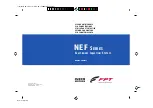
3
Safety information
Avoid skin contact with oil. Long-term or repea-
ted contact with oil can remove the natural oils
from your skin. The result can be irritation, dry
skin, eczema and other skin problems. Used oil
is more dangerous to health than new oil. Use
protective gloves and avoid oil soaked clothes
and rags. Wash regularly, especially before me-
als. Use the correct barrier cream to prevent dry
skin and to make cleaning your skin easier.
Most chemicals used in products (engine and
transmission oils, glycol, petrol and diesel oil)
and workshop chemicals (solvents and paints)
are hazardous to health Read the instructions on
the product packaging carefully! Always follow
safety instructions (using breathing apparatus,
protective goggles and gloves for example). En-
sure that other personnel are not unwittingly ex-
posed to hazardous substances (by breathing
them in for example). Ensure that ventilation is
good. Handle used and excess chemicals ac-
cording to instructions.
Be extremely careful when tracing leaks in the
fuel system and testing fuel injection nozzles.
Use protective goggles! The jet ejected from a
fuel injection nozzle is under very high pressure,
it can penetrate body tissue and cause serious
injury There is a danger of blood poisoning.
All fuels and many chemicals are inflammable.
Ensure that a naked flame or sparks cannot ig-
nite fuel or chemicals. Combined with air in cer-
tain ratios, petrol, some solvents and hydrogen
from batteries are easily inflammable and explo-
sive. Smoking is prohibited! Ensure that ventila-
tion is good and that the necessary safety pre-
cautions have been taken before carrying out
welding or grinding work. Always have a fire ext-
inguisher to hand in the workplace.
Store oil and fuel-soaked rags and fuel and oil
filters safely. In certain conditions oil-soaked
rags can spontaneously ignite. Used fuel and oil
filters are environmentally dangerous waste and
must be deposited at an approved site for de-
struction together with used lubricating oil, con-
taminated fuel, paint remnants, solvent, degrea-
sing agents and waste from washing parts.
Never expose the batteries to a naked flame or
electric sparks . Never smoke in proximity to
the batteries. The batteries give off hydrogen
gas during charging which when mixed with air
can form an explosive gas - oxyhydrogen. This
gas is easily ignited and highly volatile. Incor-
rect connection of the battery can cause a spark
which is sufficient to cause an explosion with re-
sulting damage.
Do not disturb battery connections when starting
the engine (spark risk) and do not lean over bat-
teries.
Never mix up the positive and negative battery
terminals when installing. Incorrect installation
can result in serious damage to electrical equip-
ment. Refer to wiring diagrams.
Always use protective goggles when charging
and handling batteries. The battery electrolyte
contains extremely corrosive sulfuric acid. If
this comes into contact with the skin, wash im-
mediately with soap and plenty of water. If bat-
tery acid comes into contact with the eyes, im-
mediately flush with copious amounts of water
and obtain medical assistance.
Turn off the engine and turn off power at main
switch(es) before carrying out work on the elec-
trical system.
Clutch adjustments must be carried out with the
engine turned off.
Use the lifting eyes mounted on the engine/re-
verse gear when lifting the drive unit.
Always check that lifting equipment is in good
condition and has sufficient load capacity to lift
the engine (engine weight including reverse gear
and any extra equipment installed).
To ensure safe handling and to avoid damaging
engine components on top of the engine, use a
lifting beam to raise the engine. All chains and
cables should run parallel to each other and as
perpendicular as possible in relation to the top of
the engine.
If extra equipment is installed on the engine
altering its center of gravity, a special lifting de-
vice is required to achieve the correct balance
for safe handling.
Never carry out work on an engine suspended
on a hoist.
Summary of Contents for TAMD61A
Page 2: ......
Page 86: ...84 References to Service Bulletins Group No Date Concerning ...
Page 88: ...7735718 4 English 08 1996 ...






































